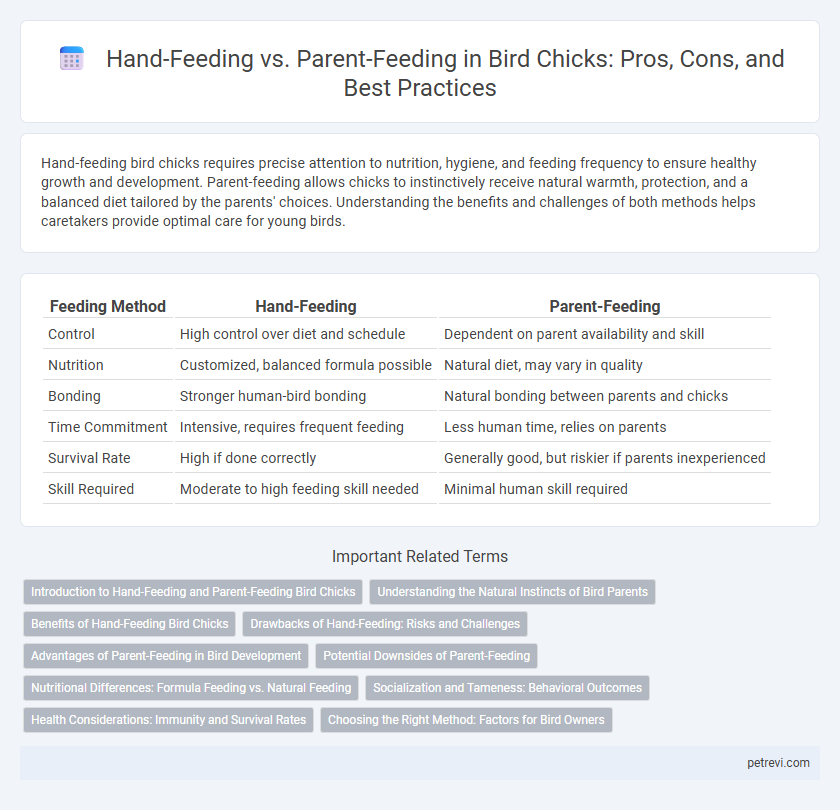Hand-feeding bird chicks requires precise attention to nutrition, hygiene, and feeding frequency to ensure healthy growth and development. Parent-feeding allows chicks to instinctively receive natural warmth, protection, and a balanced diet tailored by the parents' choices. Understanding the benefits and challenges of both methods helps caretakers provide optimal care for young birds.
Table of Comparison
| Feeding Method | Hand-Feeding | Parent-Feeding |
|---|---|---|
| Control | High control over diet and schedule | Dependent on parent availability and skill |
| Nutrition | Customized, balanced formula possible | Natural diet, may vary in quality |
| Bonding | Stronger human-bird bonding | Natural bonding between parents and chicks |
| Time Commitment | Intensive, requires frequent feeding | Less human time, relies on parents |
| Survival Rate | High if done correctly | Generally good, but riskier if parents inexperienced |
| Skill Required | Moderate to high feeding skill needed | Minimal human skill required |
Introduction to Hand-Feeding and Parent-Feeding Bird Chicks
Hand-feeding bird chicks involves humans manually feeding hatchlings with nutrient-rich formulas using syringes or spoons, ensuring precise control over diet and growth rates. Parent-feeding relies on adult birds naturally regurgitating food to nourish their offspring, promoting normal behavioral development and proper immune system strengthening. Understanding the differences in nutritional management and socialization between hand-feeding and parent-feeding techniques is crucial for successful avian chick rearing.
Understanding the Natural Instincts of Bird Parents
Parent-feeding allows bird chicks to receive essential nutrients and antibodies directly from their parents, fostering natural growth and immune system development. Hand-feeding, while useful in captivity or rescue situations, can disrupt natural instincts and bonding behaviors that bird parents instinctively use to nurture their young. Understanding these instincts helps ensure proper care that supports the chick's survival skills and social learning critical for their successful integration into the wild.
Benefits of Hand-Feeding Bird Chicks
Hand-feeding bird chicks promotes stronger human-bird bonding and socialization, which can lead to tameness and easier handling in adulthood. It enables precise control over nutrition, ensuring optimal growth by providing a balanced diet tailored to specific species needs. Early hand-feeding also allows for timely intervention in cases of illness or inadequate parental care, increasing chick survival rates.
Drawbacks of Hand-Feeding: Risks and Challenges
Hand-feeding bird chicks can expose them to nutritional imbalances, as improper formula preparation often leads to deficiencies or digestive issues. Increased risk of imprinting on humans may result in behavioral problems, hindering their ability to thrive in natural environments. Hygiene challenges during hand-feeding also elevate the chances of bacterial infections and illness in vulnerable chicks.
Advantages of Parent-Feeding in Bird Development
Parent-feeding in bird chicks promotes natural behavior development by encouraging instinctual skills such as foraging and social interaction within the nest environment. This method ensures chicks receive appropriately balanced nutrition tailored by the parents, which supports healthy growth and immune system strengthening. Enhanced survival rates have been observed in bird populations where parent-feeding practices prevail, contributing to stronger lifelong adaptability and species continuity.
Potential Downsides of Parent-Feeding
Parent-feeding bird chicks may lead to inconsistent feeding schedules and inadequate nutrition, especially if parents lack experience or face environmental stressors. This method can increase the risk of malnutrition or slower growth rates due to unpredictable food availability. Moreover, parent birds might inadvertently transmit parasites or diseases to their offspring, impacting chick survival and health.
Nutritional Differences: Formula Feeding vs. Natural Feeding
Formula feeding of bird chicks provides a controlled balance of essential nutrients, vitamins, and minerals optimized for growth, but may lack certain natural enzymes and antibodies present in parent-feeding. Parent-fed chicks receive regurgitated food that contains beneficial gut flora and immune-boosting factors that promote natural development and disease resistance. Nutritional differences between hand-feeding and parent-feeding influence digestion efficiency, immune system maturation, and long-term health outcomes in bird chicks.
Socialization and Tameness: Behavioral Outcomes
Hand-feeding bird chicks often leads to enhanced tameness and stronger human bonding due to frequent close interaction during the critical socialization period. Parent-fed chicks typically develop more natural behaviors and social skills within their species but may exhibit less inclination toward human trust and handling. The choice between hand-feeding and parent-feeding directly influences the behavioral outcomes, affecting the bird's adaptability to human environments and social interaction patterns.
Health Considerations: Immunity and Survival Rates
Hand-feeding bird chicks allows for precise control over nutrition, often resulting in higher initial survival rates compared to parent-feeding, but it may limit the transfer of natural antibodies that enhance immunity. Parent-feeding supports the development of a stronger immune system through exposure to parental microbiota and natural diet variation, which can improve long-term health and disease resistance. Studies indicate that while hand-feeding can boost early growth, parent-fed chicks tend to develop more robust immunity and better adapt to environmental challenges post-fledging.
Choosing the Right Method: Factors for Bird Owners
Bird owners must consider factors such as species-specific nutritional requirements, chick health, and the availability of time and expertise when choosing between hand-feeding and parent-feeding. Hand-feeding provides precise control over diet and monitoring but requires intensive time investment and expertise to prevent aspiration or malnutrition. Parent-feeding offers natural behavioral development and stimulates proper growth but may risk insufficient nourishment if the parents are inexperienced or stressed.
Hand-Feeding vs Parent-Feeding for Bird Chicks Infographic

 petrevi.com
petrevi.com